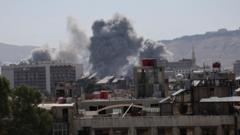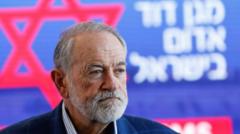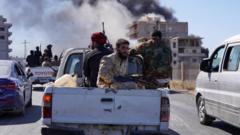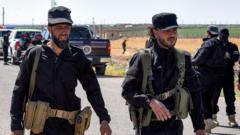This article delves into the Druze identity, the current unrest in Syria, and Israel's strategic motivations.
**Understanding the Druze Community Amidst Israel's Military Actions in Syria**

**Understanding the Druze Community Amidst Israel's Military Actions in Syria**
The escalating violence in Syria involves the Druze minority and Israel's recent military interventions.
Recent sectarian violence in Syria has drawn international attention and underscores the ongoing instability the country faces in the aftermath of a protracted civil war. Clashes erupted on Sunday, July 13, when a Druze merchant was abducted, leading to violent confrontations between Druze militias and Sunni Bedouin factions in southern Syria. The situation escalated on July 15, prompting Israel to conduct military interventions, purportedly aimed at protecting the Druze community and countering pro-government forces accused of aggression in the region. Reports indicate that over 300 individuals have lost their lives in Suweida due to this violence.
This unrest marks a significant escalation in the Druze-majority province, following earlier clashes in April and May that had already crippled the local community. Historically, the Druze are an Arabic-speaking ethno-religious minority dispersed across Syria, Lebanon, Israel, and the Golan Heights, accounting for about 3% of Syria's population. They have a distinct religious identity rooted in an offshoot of Shia Islam. Within Israel, the Druze community is generally perceived as loyal to the state, significantly due to their involvement in the Israeli military.
The Druze in Syria have long navigated a precarious political landscape, especially during the Syrian civil war, when distinct local militias formed to ensure their autonomy and safety. In recent months, as the central government under former jihadist Ahmed al-Sharaa has sought to impose control, divisions within the Druze factions have emerged regarding how they interact with the new authorities. Many in the community are implementing a cautious stance, wary of integrating into the Syrian army given the Syrian government's history of oppression against them.
Despite the Syrian government's public denunciation of attacks against the Druze, various reports reveal that some government forces have perpetrated violence against them, which has only fueled mistrust among the Druze populace. Notably, Israel has strategically engaged with the Druze community near its northern border, positioning itself as a protector of Syria's marginalized groups, including the Druze, Alawites, and Kurds, against government forces.
The recent Israeli strikes are perceived as both a warning and a deterrent against the Syrian army's deployment in the south, particularly as concerns mount over the potential rise of Islamist fighters close to the Israeli frontier. Initial strikes focused on military assets in Suweida, but expanded to critical targets in Damascus, bringing international condemnation, notably from the United States and several Arab nations.
As the situation evolves, the fragile dynamics of Syria's political and security framework remain at stake, as sectarian tensions threaten the prospect of a unified country. An analysis of the ongoing violence suggests that if control is not effectively established, fears of further fragmentation of the Syrian state under Sharaa’s leadership could manifest into a crisis that exacerbates regional instability. Israel's proactive military stance indicates its ongoing evaluation of resolving its security threats and alliances within the convoluted sectarian landscape of Syria.
This unrest marks a significant escalation in the Druze-majority province, following earlier clashes in April and May that had already crippled the local community. Historically, the Druze are an Arabic-speaking ethno-religious minority dispersed across Syria, Lebanon, Israel, and the Golan Heights, accounting for about 3% of Syria's population. They have a distinct religious identity rooted in an offshoot of Shia Islam. Within Israel, the Druze community is generally perceived as loyal to the state, significantly due to their involvement in the Israeli military.
The Druze in Syria have long navigated a precarious political landscape, especially during the Syrian civil war, when distinct local militias formed to ensure their autonomy and safety. In recent months, as the central government under former jihadist Ahmed al-Sharaa has sought to impose control, divisions within the Druze factions have emerged regarding how they interact with the new authorities. Many in the community are implementing a cautious stance, wary of integrating into the Syrian army given the Syrian government's history of oppression against them.
Despite the Syrian government's public denunciation of attacks against the Druze, various reports reveal that some government forces have perpetrated violence against them, which has only fueled mistrust among the Druze populace. Notably, Israel has strategically engaged with the Druze community near its northern border, positioning itself as a protector of Syria's marginalized groups, including the Druze, Alawites, and Kurds, against government forces.
The recent Israeli strikes are perceived as both a warning and a deterrent against the Syrian army's deployment in the south, particularly as concerns mount over the potential rise of Islamist fighters close to the Israeli frontier. Initial strikes focused on military assets in Suweida, but expanded to critical targets in Damascus, bringing international condemnation, notably from the United States and several Arab nations.
As the situation evolves, the fragile dynamics of Syria's political and security framework remain at stake, as sectarian tensions threaten the prospect of a unified country. An analysis of the ongoing violence suggests that if control is not effectively established, fears of further fragmentation of the Syrian state under Sharaa’s leadership could manifest into a crisis that exacerbates regional instability. Israel's proactive military stance indicates its ongoing evaluation of resolving its security threats and alliances within the convoluted sectarian landscape of Syria.




















